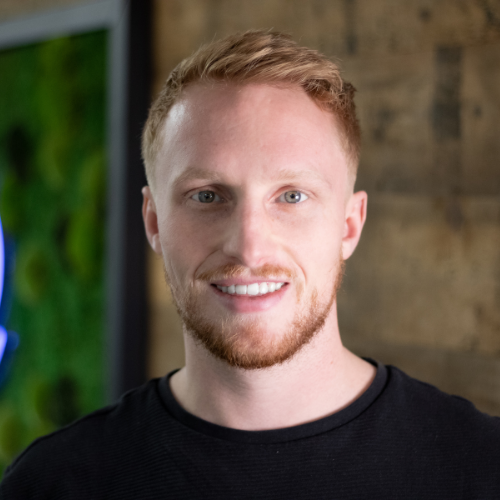
Ace Your Python Interview in 2025: A Practical Prep Guide from Hiring Pros
9th September, 2025 5 minutes
Python developers are highly sought after, from web development and data science to machine learning and automation. Getting there means going through interviews. They’re a basic part of the hiring process, yet even skilled candidates often stumble. Our recruiters say it all comes down to one thing: thorough preparation.
This guide walks you through a six-step framework for preparing, shares tips for behavioural and technical interviews, and gives level-specific advice so you know what’s expected for junior, mid-level, and senior roles. By the end, you’ll have a structured approach to research, practise, and show up confident on the day.
How to Prepare: The 6-Step Framework
Role
Start by reading the job description carefully. Identify the skills and responsibilities that matter most, and make sure your CV, portfolio, or GitHub reflects them. Prepare examples from your experience that clearly show how you meet the role’s requirements.
What good looks like: |
Company
Go beyond a Google search. Understand the company’s products, mission, culture, and tech stack. Note the team structure, recent developments, and industry context. Prepare thoughtful questions for your interviewers such as “I saw your company recently launched X. How will this team be involved?” or “What does success look like for a Python developer in the first 6 months?” This shows you’ve done your homework and gives you material for a meaningful conversation about mutual fit.
Core Python
Review key Python concepts including data types, OOP principles, standard libraries, and common syntax quirks. Revisit computer science basics like data structures (lists, dictionaries, trees, etc.), algorithms, Big-O complexity, and problem-solving techniques. Practise coding problems on paper or a simple editor without autocomplete, focusing on writing clean, correct code and communicating your thought process.
Practise
Solve coding problems from easy to medium (and hard for senior roles) on platforms like LeetCode or HackerRank. Practise under timed conditions, explain your thought process, and speak your reasoning aloud.
For mid- and senior-level roles, prepare for system design questions. Focus on component interactions, scaling, and trade-offs. Approach open-ended prompts by structuring your answers: clarify requirements, outline a high-level design, then detail and justify choices.
Don’t neglect behavioural interviews. Use the STAR method (Situation, Task, Action, Result) to share examples of teamwork, problem-solving, leadership, and other key soft skills. Clear, well-prepared answers show communication skills and self-awareness as much as technical ability.
Logistics
Plan for the practical side: confirm interview time zones, test video and audio setup, and prepare any tools or shared editors the company uses. If it’s on-site, check the route and aim to arrive early. If remote, find a quiet, well-lit space with minimal distractions.
Mindset
Rest well, stay calm, and remember: interviewers value structured thinking and reasoning over perfect answers. If you don’t know something, explain how you would approach it. Treat the interview as a professional conversation, not a performance. Once done, send a brief thank-you email to your interviewers. It’s a professional touch that leaves a strong impression.
Company Research That Moves the Needle
Interviewers and hiring managers notice when you connect your experience to their world. That means looking at what the company builds, who it serves, the tech stack it runs on, and how the team is set up. Pull in recent news or milestones too. If they’ve just launched a feature, secured funding, or written about their stack, bring that into the conversation.
Once you’ve gathered this, put it into a one-pager with headings like Product & Industry, Tech Stack, Team, Culture, and Recent News. Then use it to shape thoughtful questions, for example:
“I saw on your blog that you’re migrating part of your infrastructure to microservices. How will the Python team be involved in that, and what are some challenges you anticipate?”
“Your mission statement emphasises innovation. Can you share how the engineering culture encourages new ideas or experimentation?”
“I read that your user base grew 50% this year. How has that scaling affected the engineering priorities?”
Common pitfall: What good looks like: Linking your prep to what the company cares about today, then using it to spark a meaningful discussion. |
Mastering Behavioural Rounds
Strong Python skills get you noticed, but behavioural rounds often decide the outcome. They test how you collaborate, problem-solve, and learn from setbacks. Most behavioural interviews are framed as: “Tell me about a time when…”
The STAR framework keeps your answers structured and clear:
Situation: Set the context by briefly describing the background of the scenario.
Task: Explain your responsibility or goal.
Action: Describe what you did and why. Highlight your approach, collaboration, and Python-specific skills if relevant.
Result: Conclude with the outcome. Quantify results if possible, or share what you learned.
Keep answers specific, not generic. Show communication, problem-solving, and accountability. If you made mistakes, own them and explain how you improved. Practise speaking your answers out loud, aiming for about 1-2 minutes per response. In the interview, listen carefully, ask clarifying questions if you’re unsure, and keep your tone professional but approachable.
Examples in Action
Problem Solving
Situation: Our ETL pipeline was failing during a major data load.
Task: I had to find the bottleneck and get it running before the next cycle.
Action: I investigated logs, found memory errors, and rewrote the data batching using a generator to reduce memory usage. I coordinated with the data team to test the solution.
Result: We processed all data on time, improving pipeline efficiency by 30%. Management publicly thanked the team for salvaging the process.
Team Collaboration
Situation: A Python project required integrating features across three teams with conflicting schedules.
Task: I needed to ensure smooth collaboration and timely delivery.
Action: I set up regular check-ins, used Git and code reviews to coordinate, and clarified responsibilities to prevent overlap.
Result: The project launched on schedule, and post-launch feedback praised clear communication and teamwork.
Technical Deep-Dive by Level
Technical interviews aren’t one-size-fits-all. What’s expected of a junior is very different from a senior. Here’s what to revise and practise by level, plus sample prompts to test yourself.
Junior Python Developer (0-2 years)
It helps to focus on Python fundamentals and general programming concepts. Be confident with core data types, lists, tuples, dictionaries, sets, loops, conditionals, and simple functions. Brush up on object-oriented basics (classes, objects, inheritance) and foundational algorithms or simple data structures (arrays, stacks, queues, linked lists). Review basic sorting, searching, recursion, and Big-O complexity.
Sample prompts:
“What’s the difference between a list and a tuple?”
“Write a function to check if a string is a palindrome.”
Interviewers at this level are checking your problem-solving approach, clarity, and fundamental coding skills. Focus on writing clean code, considering edge cases, and explaining your reasoning.
Mid-Level Python Developer (2-5 years)
By now, interviewers expect depth and efficiency. Review data structures like trees, graphs, and hash tables, along with algorithms such as traversal, basic dynamic programming, and greedy approaches. Understand Python-specific concepts like generators, decorators, context managers, iterators, and concurrency (threading vs. multiprocessing). Brush up on libraries relevant to your role (Django, Flask, pandas, NumPy, etc.) and be ready to reason about component-level system design: how parts of an application interact, how to improve performance, or how to structure backend features.
Sample prompts:
“How do generators differ from lists?”
“Why might a developer choose NumPy arrays over Python lists?”
Mid-level interviews test your ability to write efficient code, reason about architecture, and work within a larger system. Demonstrate clean coding practices, strong problem-solving, and clear communication.
Senior-Level Python Developer (5+ years)
Senior roles are about breadth and depth. Focus on advanced Python internals (GIL, memory management, metaclasses, decorators, comprehensions), high-level architecture, system design, and scalability. Know standard libraries deeply, understand testing and project structure, and review any domain-specific tools or libraries. Be ready to discuss past experience, design trade-offs, and leadership in code decisions.
Mini system-design case:
Prompt: “Design a file-sharing service to handle millions of daily requests. How would Python fit in, and where are the bottlenecks?”
Your outline should cover:
Requirements (functional & non-functional)
Major components (API, database, caching, queues)
Data flow
Performance/scaling trade-offs
Seniors are expected to see the bigger picture. Show structured thinking, communicate your reasoning clearly, and balance depth with practical solutions.
Your Interview Day Checklist
Interview day nerves are normal, but thorough preparation keeps you steady. Run through this checklist before you log in or walk into the room:
Review your company research notes briefly.
Revisit your STAR stories for behavioural questions.
Skim Python syntax, key libraries, or code snippets you want to highlight.
Charge your devices, and ensure a stable internet connection if virtual.
Have a pen and paper or a notebook ready for coding or notes.
Dress appropriately and comfortably.
Arrive early (or log in early) to settle in.
Keep water nearby and stay hydrated.
Take a deep breath and stay calm.
Have a positive mindset. Treat it as a conversation, not an interrogation.
Common pitfall: What good looks like: Light review and calm focus. Trust the preparation you’ve already done. |
Smart Questions to Ask
Good candidates answer questions well. Great candidates ask smart ones back. Thoughtful questions reflect curiosity and show you’re evaluating fit, not just trying to land any job.
Role and Team
“Can you describe the team structure and how developers collaborate?”
“What’s the most exciting project your team is working on right now?”
Technology and Process
“What frameworks or tools are critical to the team’s workflow?”
“How does the team approach code reviews and testing best practices?”
Growth and Culture
“What does success look like for someone in this role in the first 6-12 months?”
“How does the team support ongoing learning and skill development?”
After the Interview: Debrief & Follow-Up
Once you log off or leave the building, capture your thoughts while they’re fresh. Take 5-10 minutes to jot down what went well, where you hesitated, and any questions you wished you’d asked. These notes will sharpen your preparation for later interviews.
Next, send a brief thank-you email. It doesn’t need to be long, but it does need to be specific.
Sample Follow-Up Email
Subject: Thank You for Today – [Your Name]
Body:
Hi [Interviewer Name],
Thank you for taking the time to speak with me today. I really enjoyed learning more about [Company] and the [Role]. I’m especially excited about [something specific you discussed].
Looking forward to the next steps.
Best regards,
[Your Name]
What good looks like: Including at least one specific detail that shows you were engaged and interested. |
Takeaways & Further Practice
Interviewing well is about combining solid technical skills with clear, confident communication. Keep practising coding without auto-complete, explaining your thought process, and testing your code for readability and correctness.
Keep up to date with Python features or popular libraries, and mention them where relevant to show your craft. Mock interviews, reviewing your code, and working on personal or open-source projects all provide practical experience and material for both technical and behavioural discussions.
Finally, approach each interview with a growth mindset. Every conversation is a chance to learn, refine your skills, and demonstrate problem-solving, passion, and readiness. With thoughtful preparation, you can enter your interview confident and ready to impress.
Are you looking for a Python role?
If you’d like tailored advice or want to learn more, reach out to Joshua Smith, he’ll be happy to help.


